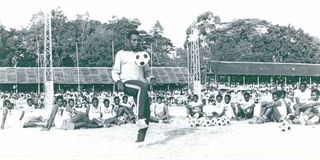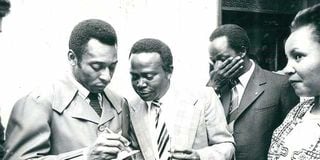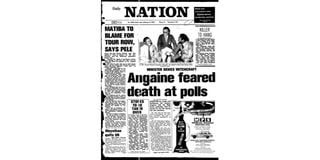When Matiba clashed with visiting Pele

Pele gives a few tips to young football players and fans at Jamhuri Park, Nairobi, during his tour of Kenya in February 1976.
What you need to know:
- 1976 tour was expected to bless Kenyan football and continue sporting culture.
- During his Kenya visit, Pele also met with the Minister for Housing and Social Services Taitta Toweett and told him how he enjoyed his Kenya visit.
The year 1976 had its fair share of good and bad turn of events in Kenya.
The country was still in shock following the murder of popular politician Josiah Mwangi “J.M.” Kariuki the previous year.
Attorney General Charles Njonjo threatened a group of Gema politicians who had started a campaign to change the constitution barring Vice President Daniel arap Moi from succeeding President Jomo Kenyatta upon his death with jail terms for imagining the death of a President.
In sports, the government boycotted the Montreal Olympic Games in an African Union countries’ led sporting sanctions against apartheid in South Africa.
Football, unlike other sports, had a mass following on and off the pitch following close to two decades of high profile European Premier League teams’ visits to Kenya.
This was the year Kenyans were looking forward to benefiting from Pele and Pepsi’s long-term training programme for youth, and a rare opportunity to watch the Brazilian in action after making the sport popular in the United States following his retirement from the Brazilian team at the end of his third World Cup in 1970.
Kenya was the preferred destination for world’s super stars, such as “007 James Bond” movies’ lead actor Roger Moore, for pleasure and humanitarian missions by 1976 and counting.
Several countries had also established cultural and sporting ties, notably Britain, Germany and the United States.
Olympic Training Centres
Germany had in 1972 seconded a coach, Bernhard Zgoll, to start Olympic Training Centres in Nairobi, Nakuru and Kisumu as a conveyor belt for football teams, a project that peaked in 1987 when some students of these centres played for Gor Mahia and Harambee Stars, Africa Cup Winners Cup and All Africa Games champions and runners up, respectively.
In athletics Mal Whitfield, an employee of the US Embassy in Nairobi who had organised the academics airlift of Kenyan students to study in US universities in the 60s, had shifted attention to runners and high profile visits to Kenya by top sports stars.
So Pele’s visit of 1976 was expected to bless Kenyan football and continue the strong sporting culture for the common good.
But it was not to be.
The Kenya Football Federation (KFF) chairman Kenneth Matiba disowned Pele’s visit, accusing the tour promoter, Pepsi Inc., of “failing to involve the federation.”

Brazilian football legend Pele (left) signs a book for ‘Nation’ editor George Mbuggus at an evening reception organised by Pepsi Kenya manager G. Butler during the star’s tour of Kenya in February, 1976.
In the end Pele’s visit showed the ugly side of football administration and Patrick Shaw, the burly police reservist from Starehe Boys Centre, a no-nonsense crime buster and the law unto himself, stepped in by ferrying Starehe boys to Jamhuri Park for the training clinic with Pele.
Fans paid with three Pepsi Cola bottle tops to watch him take on Starehe Boys Centre schoolboys through their paces.
Former Nation journalist Roy Gachuhi remembered in these pages a few ago of Matiba’s wrath: “Steve Richards, a former British sports reporter and member of Pele’s delegation, told Matiba that he had not been consulted about arrangements for Pele’s visit because he “was just a publicity seeker.”
Richards sacked
Pepsi fired and sent Richards (who was also Pele’s aide) back home before tendering an apology to Matiba who remained unconvinced.
“Matiba claimed that, as a football administrator, he was used to insults and, therefore, that was not his main beef with the tour and with Richards. It was its ambiguity: the KFF didn’t know whether Pele was here to promote football or as a Pepsi Cola salesman.
“And worst of all, his administration had been kept in the dark about all arrangements.” Pele didn’t initially react to all these.
He was happy to forget his bad Kenyan experience which he avoided mentioning in his autobiography or even acknowledge his experience at Starehe.
“It is my belief the blame lies squarely on Matiba’s shoulders,” Pele was quoted as saying in the second lead story on Page One of the Daily Nation on February 4, 1976.

Page One of the Daily Nation on February 4, 1976.
“When we arrived in Nairobi on Thursday last week, we thought everything was well according to schedule. Even when I addressed a press conference in the presence of Mr Matiba on the following day, he did not suggest anything was amiss.
Praised Matiba
“Mr Richards was here to arrange the programme in December last year and it was then that he should have been approached to make any necessary alterations in the programme,” Pele said.
But the football star nonetheless praised Matiba’s role in the development of Kenyan football, saying he bore no malice towards the Kenyan official.
During his Kenya visit, Pele also met with the Minister for Housing and Social Services Taitta Toweett and told him how he enjoyed his Kenya visit.




